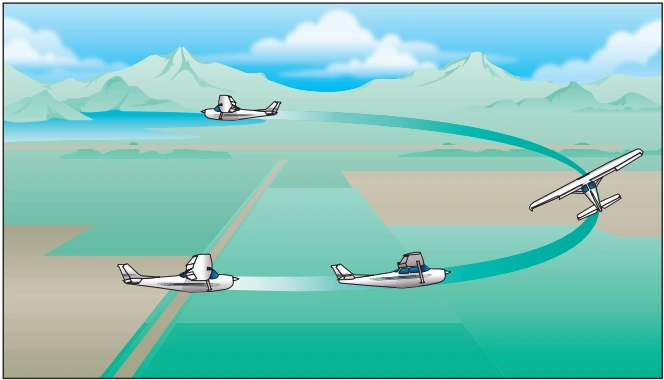Chandelles:
- Develops positive control techniques at varying airspeeds and altitudes
- According to the AOPA, a chandelle shows how much rudder is required to counteract yaw as an airplane slows and its wing angle of attack increases at high engine power, and the differences in rudder and aileron pressure when making a climbing left turn compared to a climbing right turn. A chandelle also can be a potentially lifesaving turnaround maneuver for pilots who mistakenly fly into canyons or regions of rising terrain and make a tight, 180-degree turn
Chandelle Procedure:
WARNING:
All procedures are GENERALIZED.
Always fly per Pilot Operating Handbook procedures,
observing any relevant Standard Operating Procedures (SOPs)
- Perform clearing turns
- Adjust the pitch and power to maintain altitude and set cruise power
- Trim as necessary
- Pick a prominent visual reference point at 90°, off the wing tip of the first turn
- Prominent visual reference points will help you keep situational awareness throughout the maneuver
- The farther away, the more accurate and steady the procedure can be flown
- Initiate a roll into a 30° bank in the direction of the reference point
- After the bank is established, initiate a climbing turn by smoothly applying elevator back-pressure to increase the pitch attitude, and apply full power
- While maintaining a 30° bank, continue increasing the pitch attitude at a constant rate so as to attain the highest pitch altitude at the 90° point (reference point) in the turn
- At the 90° point in the turn, maintain the pitch attitude by continuing to increase back-pressure (due to decreasing airspeed) and initiate a slow rate of roll-out so as to arrive at the 180° point with the wings level (reference point off from the opposite wing) and at minimum controllable airspeed (stall warning)
- Right turn: Roll out can be done primarily with the right rudder
- Left turn: Roll out can be done primarily with left aileron
- To recover, maintain the heading while decreasing the pitch attitude, allowing the airplane to accelerate while maintaining the last altitude attained
- As cruise airspeed is attained, set cruise power
- Re-trim as necessary
- Complete cruise checklist
Chandelle Common Errors:
- Failure to adequately clear the area
- Too shallow an initial bank, resulting in a stall
- Too steep an initial bank, resulting in failure to gain maximum performance
- Allowing the actual bank to increase after establishing initial bank angle
- Failure to start the recovery at the 90° point in the turn
- Allowing the pitch attitude to increase as the bank is rolled out during the second 90° of turn
- Removing all of the bank before the 180° point is reached
- Nose low on recovery, resulting in too much airspeed
- Control roughness
- Poor coordination (slipping or skidding)
- Stalling at any point during the maneuver
- Execution of a steep turn instead of a climbing maneuver
- Failure to scan for other aircraft
- Attempting to perform the maneuver by instrument reference rather than visual reference
Chandelles Airman Certification Standards:
Chandelles Knowledge:
The applicant must demonstrate an understanding of:-
CA.V.C.K1:
Purpose of chandelles -
CA.V.C.K2:
Aerodynamics associated with chandelles, to include:-
CA.V.C.K2a:
Coordinated and uncoordinated flight -
CA.V.C.K2b:
Overbanking tendencies -
CA.V.C.K2c:
Maneuvering speed, including the impact of weight changes -
CA.V.C.K2d:
Accelerated stalls
-
-
CA.V.C.K3:
Appropriate airplane configuration for maximum performance climb -
CA.V.C.K4:
Proper pitch control required for continuously decreasing airspeed
Risk Management:
The applicant demonstrates the ability to identify, assess, and mitigate risks, encompassing:-
CA.V.C.R1:
Failure to divide attention between airplane control and orientation -
CA.V.C.R2:
Collision hazards, to include aircraft and terrain -
CA.V.C.R3:
Low altitude maneuvering, including stall or spin -
CA.V.C.R4:
Distractions, loss of situational awareness, or improper task management -
CA.V.C.R5:
Failure to maintain coordinated flight -
CA.V.C.R6:
Failure to manage energy state -
CA.V.C.R7:
Rate and radius of turn with confined area operations
Skills:
The applicant demonstrates the ability to:-
CA.V.C.S1:
Clear the area -
CA.V.C.S4: Select an altitude that will allow the maneuver to be performed no lower than 1,500 feet above ground level (AGL)
-
CA.V.C.S3: Establish the appropriate entry configuration, power, and airspeed
-
CA.V.C.S4: Establish the angle of bank at approximately 30°
-
CA.V.C.S5: Simultaneously apply power and pitch to maintain a smooth, coordinated climbing turn, in either direction, to the 90° point, with a constant bank and continuously decreasing airspeed
-
CA.V.C.S6: Begin a coordinated constant rate rollout from the 90° point to the 180° point maintaining power and a constant pitch attitude
-
CA.V.C.S7: Complete rollout at the 180° point, ±10° just above a stall airspeed, and maintaining that airspeed momentarily avoiding a stall
-
CA.V.C.S8: Resume a straight-and-level flight with minimum loss of altitude
Conclusion:
- Atmospheric conditions will effect altitude gained, the altitude is not what matters however
- Consider practicing maneuvers on a flight simulator to introduce yourself to maneuvers or knock off rust
- Still looking for something? Continue searching:
